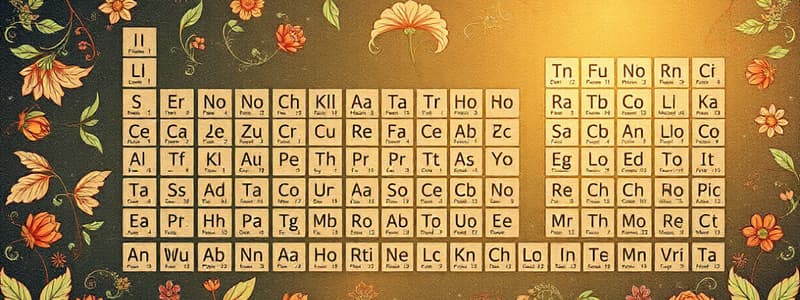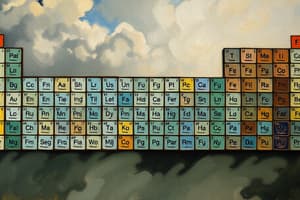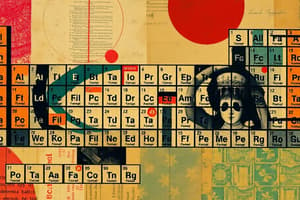Podcast
Questions and Answers
What is the name of the compound with the formula CrBr3?
What is the name of the compound with the formula CrBr3?
- Chromium Bromide
- Chromium Tribromide
- Chromium (III) Bromide (correct)
- Chromium (I) Bromide
What is the formula for phosphorus pentachloride?
What is the formula for phosphorus pentachloride?
- PCl3
- P5Cl
- PCl5 (correct)
- P2Cl5
Which of the following characterizes a molecular compound?
Which of the following characterizes a molecular compound?
- Good conductor of electricity
- High melting point
- Forms a lattice structure
- Weak bonds between atoms (correct)
What is the name of the negatively charged ion formed when an element gains electrons?
What is the name of the negatively charged ion formed when an element gains electrons?
Which of the following is an example of an ionic compound?
Which of the following is an example of an ionic compound?
What is the name of the ion formed when Bromine gains an electron?
What is the name of the ion formed when Bromine gains an electron?
What is the name of the compound formed by the reaction of gold and sulfur?
What is the name of the compound formed by the reaction of gold and sulfur?
Which of the following correctly describes the properties of a metal?
Which of the following correctly describes the properties of a metal?
What does the term 'isotope' refer to?
What does the term 'isotope' refer to?
Which of the following is a characteristic of both ionic and molecular compounds?
Which of the following is a characteristic of both ionic and molecular compounds?
What is the formula for the compound formed by the reaction of potassium and chlorine?
What is the formula for the compound formed by the reaction of potassium and chlorine?
How many atoms are in one mole of any substance?
How many atoms are in one mole of any substance?
What is the mass number of an element?
What is the mass number of an element?
Which of the following elements is a metaloid?
Which of the following elements is a metaloid?
Which statement describes the formation of a covalent bond?
Which statement describes the formation of a covalent bond?
What is the primary function of combustion analysis?
What is the primary function of combustion analysis?
Which of the following properties is generally associated with ionic compounds?
Which of the following properties is generally associated with ionic compounds?
How can you determine the number of neutrons in an atom?
How can you determine the number of neutrons in an atom?
Which of the following best describes the term 'atomic mass' as it relates to the periodic table?
Which of the following best describes the term 'atomic mass' as it relates to the periodic table?
What color on the periodic table represents a solid element?
What color on the periodic table represents a solid element?
What are the two main types of chemical formulas?
What are the two main types of chemical formulas?
What is the variable charge of gold?
What is the variable charge of gold?
Which of the following ions is a polyatomic ion?
Which of the following ions is a polyatomic ion?
What is the chemical formula for the ion acetate?
What is the chemical formula for the ion acetate?
What is the molarity of a solution that contains 0.25 moles of solute dissolved in 500 mL of solution?
What is the molarity of a solution that contains 0.25 moles of solute dissolved in 500 mL of solution?
Which of the following is NOT a characteristic of a solution?
Which of the following is NOT a characteristic of a solution?
When the element is #+, does it gain or lose electrons and what increases?
When the element is #+, does it gain or lose electrons and what increases?
What is the name of the ion Cr2O72-?
What is the name of the ion Cr2O72-?
Which of the following is the correct formula for the ion ammonium?
Which of the following is the correct formula for the ion ammonium?
What is the charge of the phosphate ion?
What is the charge of the phosphate ion?
What is the formula for the compound formed by the combination of calcium ions (Ca²⁺) and phosphate ions (PO₄³⁻)?
What is the formula for the compound formed by the combination of calcium ions (Ca²⁺) and phosphate ions (PO₄³⁻)?
What is the name of the polyatomic ion with the formula SO₄²⁻?
What is the name of the polyatomic ion with the formula SO₄²⁻?
Which of the following compounds contains the nitrate ion (NO₃⁻)?
Which of the following compounds contains the nitrate ion (NO₃⁻)?
What is the formula for the phosphate ion?
What is the formula for the phosphate ion?
Which of the following compounds contains the ammonium ion?
Which of the following compounds contains the ammonium ion?
Identify the polyatomic ion present in the compound Al₂(SO₄)₃.
Identify the polyatomic ion present in the compound Al₂(SO₄)₃.
Which of the following is NOT a characteristic of a polyatomic ion?
Which of the following is NOT a characteristic of a polyatomic ion?
Which of the following compounds contains the carbonate ion?
Which of the following compounds contains the carbonate ion?
How many nitrate ions are present in the formula Cu(NO₃)₂?
How many nitrate ions are present in the formula Cu(NO₃)₂?
Which of the following polyatomic ions has a charge of 2-?
Which of the following polyatomic ions has a charge of 2-?
Flashcards
Nucleus
Nucleus
Core of the atom that contains protons and neutrons.
Electrons
Electrons
Negatively charged particles located outside the nucleus.
Mass Number
Mass Number
Total number of protons and neutrons in an atom.
Isotopes
Isotopes
Signup and view all the flashcards
Chemical Formulas Types
Chemical Formulas Types
Signup and view all the flashcards
Periodic Table Groups
Periodic Table Groups
Signup and view all the flashcards
Metal Properties
Metal Properties
Signup and view all the flashcards
Combustion Analysis
Combustion Analysis
Signup and view all the flashcards
Sulfide
Sulfide
Signup and view all the flashcards
Nitride
Nitride
Signup and view all the flashcards
Cation
Cation
Signup and view all the flashcards
Anion
Anion
Signup and view all the flashcards
Roman numerals in naming
Roman numerals in naming
Signup and view all the flashcards
Molecular compounds
Molecular compounds
Signup and view all the flashcards
Avogadro's number
Avogadro's number
Signup and view all the flashcards
Formula mass
Formula mass
Signup and view all the flashcards
Metalloids
Metalloids
Signup and view all the flashcards
Ions
Ions
Signup and view all the flashcards
Covalent bond
Covalent bond
Signup and view all the flashcards
Ionic bond
Ionic bond
Signup and view all the flashcards
Molecular compound properties
Molecular compound properties
Signup and view all the flashcards
Ionic compounds properties
Ionic compounds properties
Signup and view all the flashcards
Variable charge of Co
Variable charge of Co
Signup and view all the flashcards
Variable charge of Ni
Variable charge of Ni
Signup and view all the flashcards
Variable charge of Cu
Variable charge of Cu
Signup and view all the flashcards
Variable charge of Zn
Variable charge of Zn
Signup and view all the flashcards
Variable charge of Ag
Variable charge of Ag
Signup and view all the flashcards
Variable charge of Au
Variable charge of Au
Signup and view all the flashcards
Molarity Formula
Molarity Formula
Signup and view all the flashcards
Solution
Solution
Signup and view all the flashcards
Permanganate ion charge
Permanganate ion charge
Signup and view all the flashcards
Magnesium phosphate formula
Magnesium phosphate formula
Signup and view all the flashcards
Polyatomic ion in KNO3
Polyatomic ion in KNO3
Signup and view all the flashcards
Nitrate ion
Nitrate ion
Signup and view all the flashcards
Common polyatomic ions
Common polyatomic ions
Signup and view all the flashcards
Polyatomic Ions
Polyatomic Ions
Signup and view all the flashcards
Sulfate Ion
Sulfate Ion
Signup and view all the flashcards
Phosphate Ion
Phosphate Ion
Signup and view all the flashcards
Hydroxide Ion
Hydroxide Ion
Signup and view all the flashcards
Carbonate Ion
Carbonate Ion
Signup and view all the flashcards
Ammonium Ion
Ammonium Ion
Signup and view all the flashcards
Identifying Polyatomic Ions
Identifying Polyatomic Ions
Signup and view all the flashcards
Study Notes
Atomic Structure and Properties
- Atoms are composed of protons, neutrons, and electrons
- The nucleus, containing protons and neutrons, is dense and positively charged
- Electrons orbit the nucleus and are negatively charged
- Protons and neutrons are heavy subatomic particles
- Electrons are light subatomic particles
Atomic Number and Mass Number
- Atomic number defines an element and equals the number of protons.
- Mass number is the total number of protons and neutrons in an atom
- Calculate neutrons: Mass number - Atomic number = number of neutrons
The Periodic Table
- Elements are organized by their properties.
- Arrangement: Red, blue, black, and clear colors are used to categorize elements as liquids, gases, solids, or synthetic, respectively on the periodic table.
- Periods: Horizontal rows on the periodic table
- Groups: Vertical columns on the periodic table
- Metal properties: Shiny, malleable, ductile, conductive, sometimes magnetic
- Nonmetal properties: Dull, brittle, poor conductors
- Metalloid properties: Properties of both metals and nonmetals
Isotopes
- Isotopes are atoms of the same element with different neutron numbers, meaning different mass numbers.
- Isotopes have the same number of protons but different numbers of neutrons.
Chemical Formulas
- Two types of chemical formulas exist: empirical and molecular formulas.
Atomic Mass
- The average mass of an element's atoms, considering the relative abundance of its isotopes
Combustion Analysis
- Determining the elemental composition of a substance by combustion to find the empirical formula
Ions
- Ions are atoms that have gained or lost electrons, giving them a positive or negative charge.
- Cations are positively charged ions
- Anions are negatively charged ions
Types of Bonds
- Covalent bonds: atoms share electrons
- Ionic bonds: atoms transfer electrons
Molecular Compounds & Properties
- Formed from two or more nonmetals
- Properties: weak bonds (low melting and boiling points), poor heat and electrical conductivity, and typically exist as solids, liquids, or gases at room temperature.
Ionic Compounds & Properties
- Formed from a metal and a nonmetal
- Properties: high melting and boiling points, hard and brittle, conduct electricity when melted or dissolved in water, and generally occur as solids at room temperature.
Chemical Nomenclature
- Rules for naming chemical compounds, including compounds with variable charges (indicated using Roman numerals)
Atomic Elements
- Elements existing as single atoms
Molecular Elements
- Elements existing as two or more atoms bonded together (molecules)
Monoatomic Anions
- Anions composed of one atom
Periodic Table Elements
- Specific elements listed by name and formula including: Fluorine (F-), Chloride (Cl-), Bromide (Br-), Iodine (I-), Oxide (O2-), Sulfide (S2-), Nitride (N3-), Phosphide (P3-).
Identifying and Calculating Molarity, Solutions, Solvents & Solutes.
- Molarity: amount of solute per liter of solution
- Solution: a homogeneous mixture of two or more substances.
- Solvent: the substance in which the solute dissolves.
- Solute: the substance that dissolves in the solvent
Formula for Dilution Problems
- M1V1=M2V2
Studying That Suits You
Use AI to generate personalized quizzes and flashcards to suit your learning preferences.




